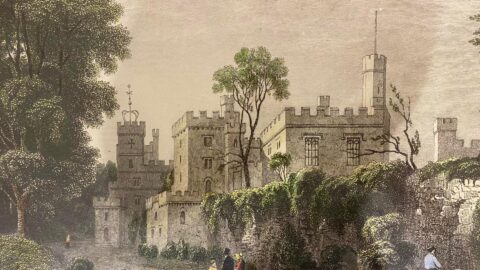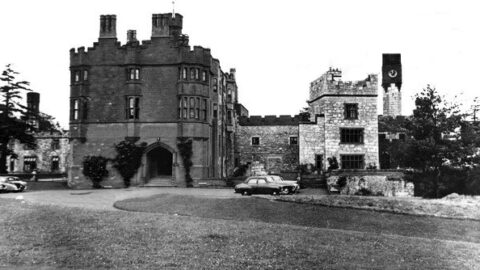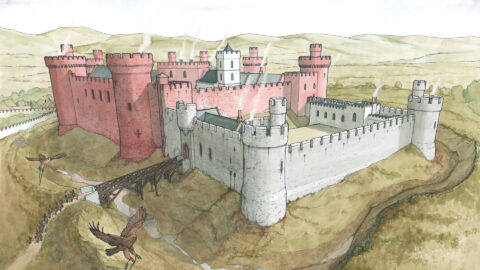19th - 20th Century
RUTHIN CASTLE HISTORY
Almost two centuries later, in 1826, Ruthin Castle benefitted from being purchased by the wealthy Myddleton family, who invested heavily in creating & extending the residential castle mansion & in doing so, invested in many repairs to the medieval castle ruins & in laying out the gardens & grounds.
The first portion of the stone castle mansion was built within the medieval stone castle ruins in 1826 & in 1848 Frederick Richard West, son of Frederick West, commissioned Henry Clutton (later Sir Henry Clutton) to rebuild part of the castle erected by his father.
The main block was partly demolished & replaced by a three-story castellated building in red sandstone, with octagonal corner tower. The northern wing which intrudes onto the garden layout was added sometime after 1879.


Ruthin Castle & its castle mansion gained most notoriety when owned by the Cornwallis-West family (which had evolved from the Myddleton family) & became ‘the centre of dangerous romantic intrigue at the highest level’. Colonel Cornwallis-West’s wife ‘Patsy’ is said to have become embroiled in a long love affair with Edward, Prince of Wales (later becoming King Edward VII).
Beautiful Patsy was just 16 years old when she married & was at the height of society, notorious as a flirt, & full of the joys of life. Patsy frequently entertained the very height of Edwardian Society at Ruthin Castle including the Prince of Wales, politicians, famous entertainers (such as the actress Lillie Langtry) & Jenny Jerome, also known as Lady Randolph Churchill (mother of Sir Winston Churchill and later the wife of her son, George Cornwallis-West). George was 20 years younger than Jenny, & owner of the castle at that time. Patsy also had two notable daughters, Shelagh, who married the powerful Duke of Westminster to become the Duchess of Westminster, & Daisy, who fell in love with her own Prince, Hans Heinrich of Pless, part of a family owning enormous estates in south-eastern Germany & considered ‘fabulously wealthy’.
Hers was a fairytale wedding attended by world royalty, nobility, statesmen & members of high society. When she arrived at her new home the streets were lined with crowds for miles & she developed a reputation similar to that more recently of Diana, Princess of Wales. Tragically the events of World War I turned Princess Daisy’s world upside down and resulted in divorce, bad health & death in poverty.


Between 1923 and 1962, Ruthin Castle was used as a clinic/private hospital for the ‘scientific investigation and treatment of illness, and for the maintenance of health in those with no disease.’ Their advertising made much of the natural splendours of the local environment – the castle grounds, the scenery, the air, and the opportunities for walks. Infectious diseases or mental illnesses were not treated, the focus being on stomach complaints, emaciation, heart, lung, and arterial disease. There is no doubt that the quality of the medical treatment, and the pioneering research work arising from it, was of the best. Its reputation attracted famous people of the day, including reputedly, Sir Laurence Olivier and Omar Sharif.
In the early 1960’s Ruthin Castle was purchased at auction by the Warburton family & converted into a 58 bedroom luxury hotel. Within a few years it won an award for an ‘outstanding contribution made to British tourism.’ One of the most notable guests to have visited was HM King Charles III who stayed at the hotel the night prior to his investiture as Prince of Wales in 1969 (the 21st Prince of Wales since the new title began in 1301).




